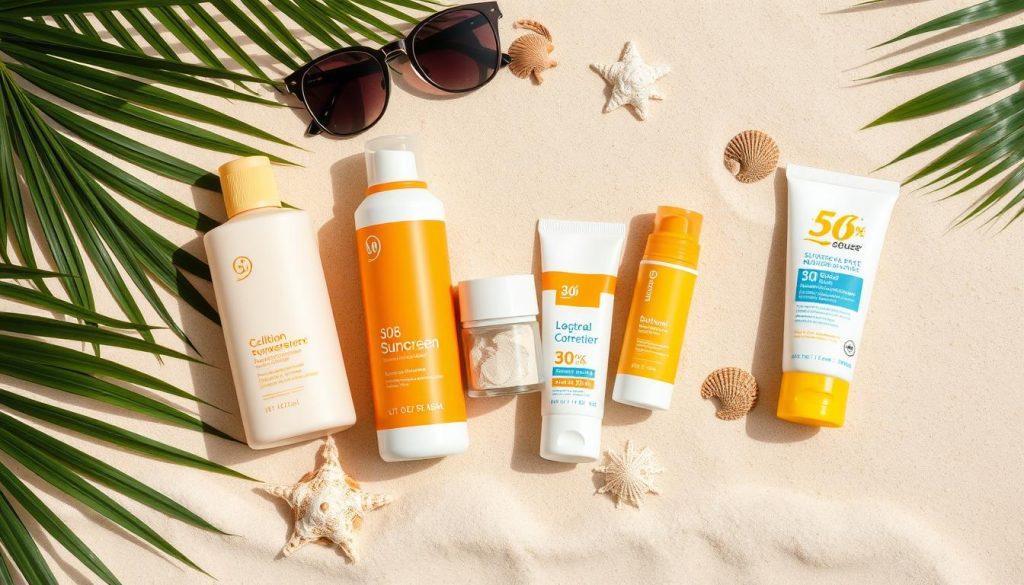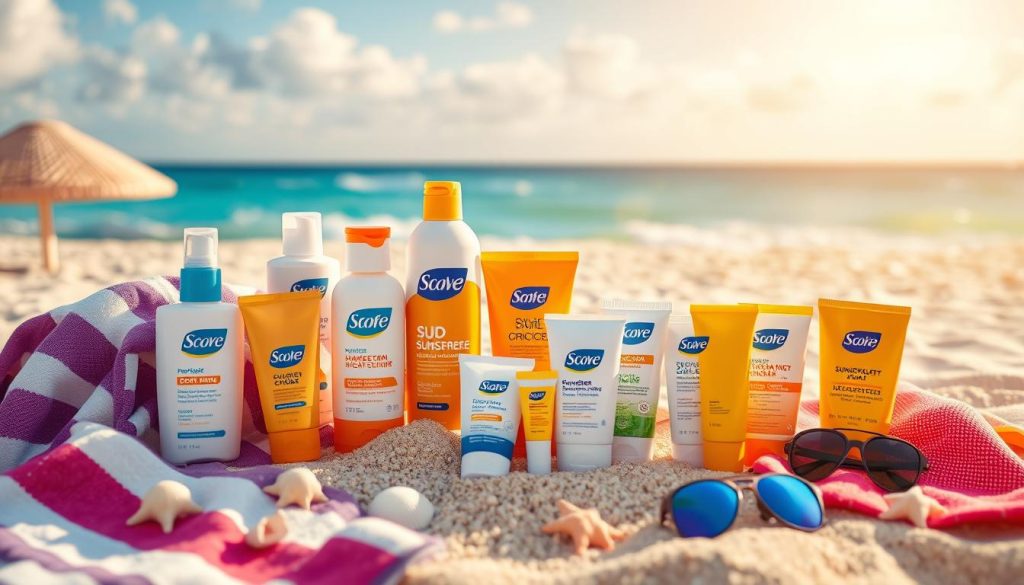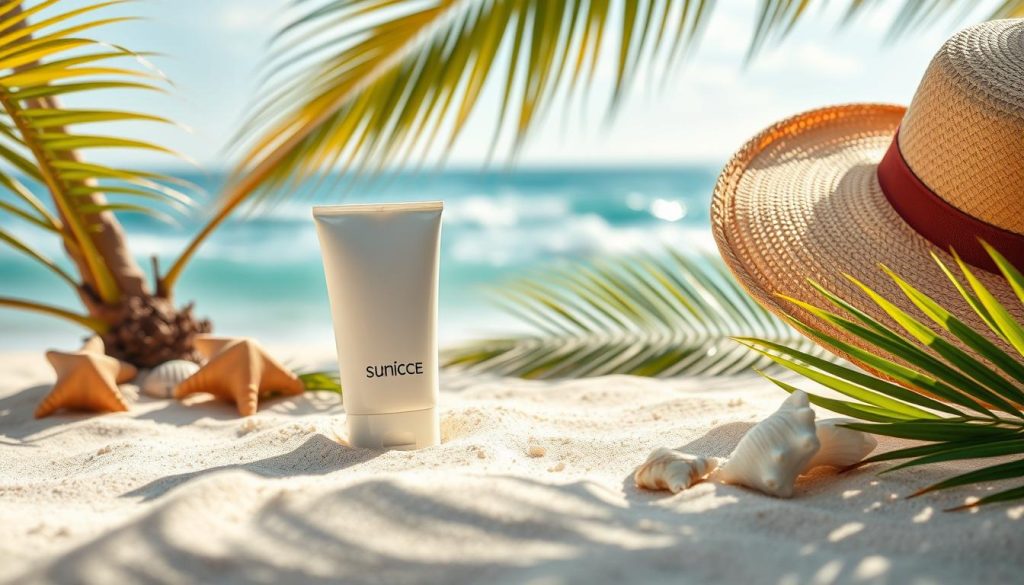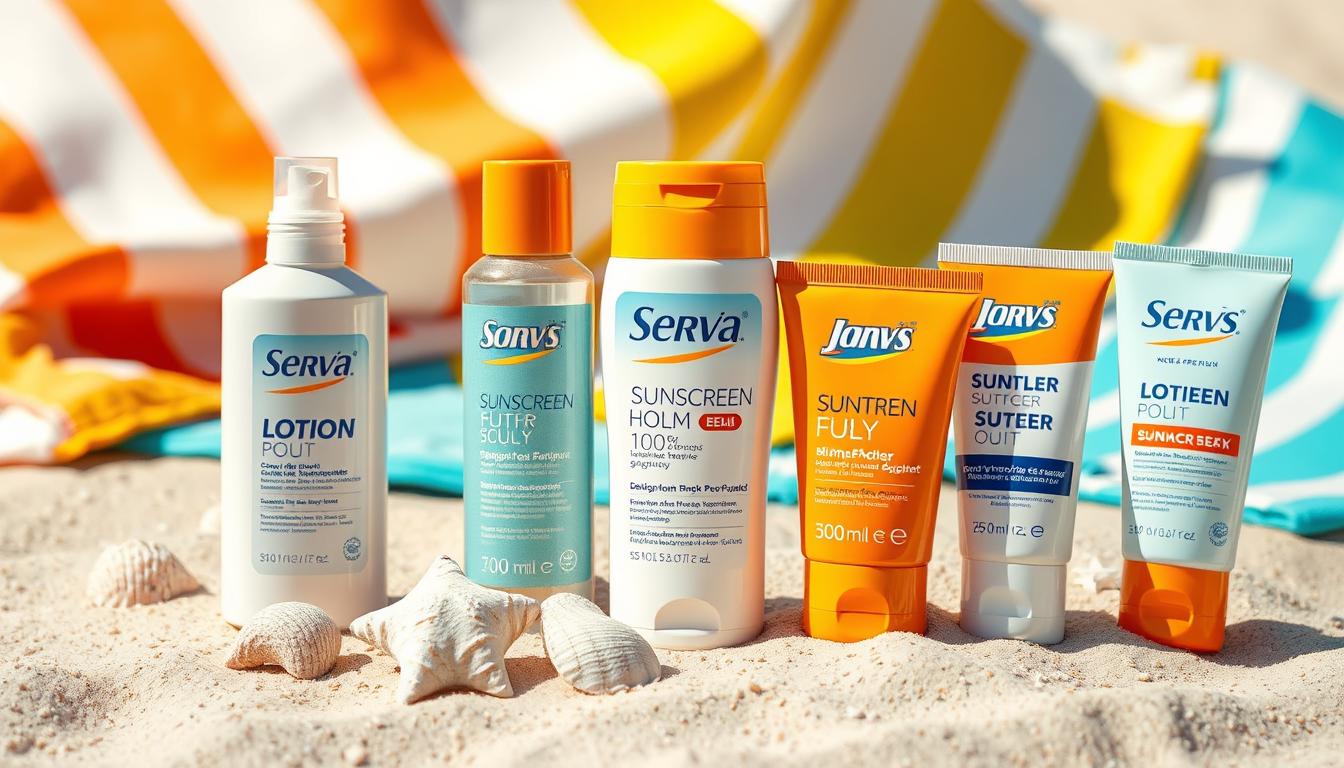I’m here to help you pick the best sunscreen for your needs. With many choices, picking the right one can be tough. Whether you’re going for a run or just out and about, knowing the differences is crucial.
Finding the right sunscreen is important for sun protection. In this guide, we’ll explore lotions, sprays, powders, sticks, and gels. This will help you find the perfect match for your lifestyle and preferences, ensuring you get the best protection.
Why Your Sunscreen Formula Choice Matters
Choosing the right sunscreen is more than just picking a brand. The formula you pick is key for sun protection and skin health. Each type offers special benefits for different skin types and lifestyles.

The Science Behind Different Formulations
Every sunscreen type—lotion, spray, powder, stick, or gel—is made with special ingredients. Chemical sunscreens turn UV rays into heat. Mineral sunscreens block and scatter UV radiation with active minerals like zinc oxide. Knowing these differences helps you pick the right sunscreen for your skin.
Impact on UV Protection Levels
Not all sunscreens protect equally. SPF rating and broad-spectrum agents matter for UVA and UVB protection. Higher SPF means better protection, but the formula also plays a role. Choose a sunscreen that fits your daily needs.
Absorption and Staying Power
The formula impacts how sunscreen absorbs and lasts. Creams and lotions are good for dry skin. Sprays are quick for busy people. Some formulas need more frequent use, like during intense activities or long sun time. Pick a sunscreen that stays effective all day.
Understanding SPF and Protection Basics
When picking a sunscreen, knowing what SPF means is key for sun protection. SPF stands for Sun Protection Factor. It shows how well a product blocks UVB rays, which cause sunburn. For example, SPF 30 means you can stay in the sun 30 times longer without burning.
But UVB isn’t the only danger. UVA rays go deeper, causing early aging and skin cancer. That’s why it’s important to choose a sunscreen that protects against both UVA and UVB rays. Remember, higher SPF doesn’t always mean more protection. SPF 30 blocks about 97% of UVB rays, while SPF 50 blocks around 98%. No sunscreen blocks 100% of rays.
Here’s a quick overview of what different SPF levels offer:
- SPF 15: Blocks 93% of UVB rays
- SPF 30: Blocks 97% of UVB rays
- SPF 50: Blocks 98% of UVB rays

Knowing these basics helps you choose the right sunscreen. It ensures you get the best sun protection for your skin and lifestyle.
| SPF Level | Percentage of UVB Rays Blocked |
|---|---|
| SPF 15 | 93% |
| SPF 30 | 97% |
| SPF 50 | 98% |
Sunscreen Lotions: The Classic Choice
Sunscreen lotions have been a go-to for years to block harmful UV rays. Their creamy texture makes them easy to apply smoothly and evenly. This is why many people love them.

Benefits of Lotion Formulations
Lotion sunscreens offer great coverage that blends well with your skin. They also have moisturizers to keep your skin hydrated. This way, they protect your skin from the sun while keeping it moist.
Best Application Techniques
To get the most protection, apply sunscreen lotion generously 15 minutes before going outside. Make sure to cover areas like ears, neck, and the back of your hands. Reapply every two hours, or after swimming or sweating.
Who Should Choose Lotions
Lotion sunscreens are perfect for:
- People with dry skin who need extra moisture.
- Those who spend a lot of time outside.
- Anyone who wants a thicker, more protective layer.
There are water-resistant options for lasting protection during different activities. Choosing the right lotion sunscreen keeps your skin safe and comfortable all day.
| Brand | SPF | Key Features |
|---|---|---|
| Neutrogena Hydro Boost | 30 | Moisturizing, Non-greasy |
| Coppertone Sport | 50 | Water-resistant, Broad Spectrum |
| La Roche-Posay Anthelios | 60 | High protection, Suitable for sensitive skin |
Spray Sunscreens: Convenience in a Can

Spray sunscreens are quick and easy to use. They’re great for spots like your back and shoulders that are hard to reach.
They provide even coverage, which is a big plus. This type is light and doesn’t feel heavy like lotions do. It’s perfect for hiking, beach trips, or running errands.
But, there are things to watch out for. It can be hard to get even coverage. Also, there’s a chance you might breathe it in while applying. Always spray in a well-ventilated area and keep the can away from your skin.
Choose a spray sunscreen with broad-spectrum protection and a high SPF. Brands like Neutrogena and Coppertone are good choices. They suit different skin types and activities.
- Aim the spray away from your face to avoid inhalation.
- Hold the can at least 6 inches from your skin for even coverage.
- Apply an extra layer manually on areas prone to missing coverage.
| Advantages | Disadvantages |
|---|---|
| Easy application on hard-to-reach areas | Risk of inhalation if not applied carefully |
| Quick drying and lightweight feel | Potential for uneven coverage |
| Ideal for on-the-go lifestyles | Requires careful use in windy conditions |
Powder Sunscreens: The Newest Innovation
Powder sunscreens are quickly becoming a must-have in my daily skincare routine. They feel light and are easy to apply. This makes them perfect for many situations.

Mineral vs. Chemical Powder Options
There are two types of powder sunscreens: mineral and chemical. Mineral sunscreens use zinc oxide to reflect UV rays. Chemical powders absorb UV radiation to protect your skin. Choose the one that suits your skin type and preferences.
Perfect Scenarios for Powder Use
Powder sunscreens are great for certain situations. They’re perfect for quick touch-ups when you’re on the move. They also work well over makeup to control shine without messing up your foundation. This is ideal for long, active days.
Application Tips and Tricks
To get the best results, use a clean brush to apply powder sunscreen. Make sure to cover all exposed areas, like your ears and neck. Don’t overdo it to avoid a cakey look. Regular use keeps your skin protected and looking fresh.
Stick Sunscreens: Targeted Protection
Stick sunscreens are easy to carry and use anywhere. They fit well in your bag, making it simple to protect your skin on the go.
Stick sunscreens are great because they let you apply sunscreen precisely. You can cover hard-to-reach spots like your nose and ears without mess. They’re also good for areas around your eyes.
Stick sunscreens are perfect for:
- Protecting sensitive areas
- Children who need easy application
- Active individuals who need quick reapplication
Here are some tips for using stick sunscreens effectively:
- Apply generously to ensure full coverage
- Use a gentle touch to avoid skin irritation
- Reapply after swimming or sweating
| Brand | SPF | Features |
|---|---|---|
| Neutrogena | 50 | Water-resistant, Non-greasy |
| Banana Boat | 45 | Broad-spectrum, Easy application |
| Coppertone | 30 | Budget-friendly, Portable |
Gel Sunscreens: Light and Fresh
Choosing sunscreen can be tough, but gel formulas are a great option. They’re light and feel refreshing. I find them perfect for hot summer days because they don’t feel greasy.
Gel sunscreens come in two types: water-based and alcohol-based. Each has its own benefits for different skin needs.
Water-Based vs. Alcohol-Based Gels
Water-based gels are best for sensitive or dry skin. They moisturize and protect from UV rays. Alcohol-based gels dry quickly and are good for oily or acne-prone skin. When picking a sunscreen, I think about my skin type and what I need for the day.
Ideal Skin Types for Gel Formulas
Gel sunscreens are great for oily or combination skin. They don’t clog pores, making them perfect for everyday use. They also stay on well, even when you sweat or get wet.
To use gel sunscreen right, apply it all over your skin. Reapply every two hours to keep your skin protected, whether you’re outside for a long time.
Lotion, Spray, Powder, Stick, or Gel: Which Sunscreen Is Right for You?
Choosing sunscreen doesn’t have to be confusing. With options like lotion, spray, powder, stick, and gel, it’s easier to find the perfect fit for your needs.
Matching Formula to Skin Type
Your skin type is key when picking sunscreen. For oily or acne-prone skin, a gel or powder sunscreen can help reduce shine. Dry skin benefits from the moisturizing properties of a lotion. If you have sensitive skin, a stick sunscreen provides targeted protection without irritation.
Activity-Based Selection Guide
Your daily activities influence which sunscreen to choose. If you’re swimming or sweating, a spray or gel sunscreen offers long-lasting protection. For hiking or outdoor sports, a stick sunscreen is easy to apply on the go. Everyday wear is well-suited for a classic lotion that covers all areas evenly.
Climate Considerations
Different climates require different sunscreen formulas. In hot and humid weather, a spray or powder sunscreen keeps you cool without feeling heavy. For colder climates, a rich lotion can provide additional moisture. Gel sunscreens work well in mild climates, offering light protection without greasiness.
| Situation | Recommended Sunscreen Type |
|---|---|
| Oily or Acne-Prone Skin | Gel or Powder |
| Dry Skin | Lotion |
| Sensitive Skin | Stick |
| Swimming or Sweating | Spray or Gel |
| Hiking or Outdoor Sports | Stick |
| Everyday Wear | Lotion |
| Hot and Humid Climate | Spray or Powder |
| Cold Climate | Lotion |
| Mild Climate | Gel |
Common Application Mistakes to Avoid
Even the best sunscreen won’t protect your skin if it’s not applied correctly. I’ve noticed that many people make simple mistakes that reduce their sun protection effectiveness.
- Using Too Little Sunscreen: Applying less than the recommended amount can leave your skin vulnerable. Make sure to cover all exposed areas generously.
- Missing Key Areas: Don’t forget spots like ears, neck, and the back of your hands. These areas are often overlooked but need proper skin protection.
- Not Reapplying Regularly: Sunscreen wears off over time, specially if you’re swimming or sweating. Reapply every two hours to maintain sun protection.
- Improper Storage: Keep your sunscreen in a cool, dry place. Heat and sunlight can degrade the product, making it less effective.
- Using Expired Products: Check the expiration date regularly. Expired sunscreen might not provide the necessary skin protection.
To ensure you’re getting the full benefit of your sunscreen, follow these tips diligently. Proper application is key to effective sun protection and maintaining healthy skin.
My Top Recommendations for Every Lifestyle
Choosing the right sunscreen can make your daily routine better and protect your skin. There’s a perfect option for everyone, whether you like lotion, spray, powder, stick, or gel.
For everyday use, I suggest Neutrogena Ultra Sheer Lotion SPF 50. It’s light and absorbs fast. If you’re always outdoors, Banana Boat Ultra Sport Spray SPF 50 is great for lasting protection.
For beach days, Supergoop! Mineral Powder SPF 30 gives a matte look and is easy to reapply. For specific spots, EltaMD UV Defense Lip Balm SPF 31 is perfect for lips and small areas. For a gel, La Roche-Posay Anthelios Clear Skin SPF 60 feels fresh and doesn’t clog pores.
For those who care about the environment, Sun Bum Mineral SPF 50 and ThinkSport SPF 50+ are great. They’re reef-safe and protect your skin and the planet.
| Type | Product | SPF | Key Features | Price Range |
|---|---|---|---|---|
| Lotion | Neutrogena Ultra Sheer Lotion SPF 50 | 50 | Lightweight, fast-absorbing | $ |
| Spray | Banana Boat Ultra Sport Spray SPF 50 | 50 | Durable, sweat-resistant | $$ |
| Powder | Supergoop! Mineral Powder SPF 30 | 30 | Matte finish, easy reapplication | $$ |
| Stick | EltaMD UV Defense Lip Balm SPF 31 | 31 | Targeted protection, portable | $$ |
| Gel | La Roche-Posay Anthelios Clear Skin SPF 60 | 60 | Oil-free, non-comedogenic | $$$ |
Conclusion: Making Your Final Sunscreen Choice
Choosing the right sunscreen is key to protecting your skin from the sun. Each type, like lotion, spray, or gel, has its own benefits. It’s important to pick one that fits your routine and feels good on your skin.
I think about my skin type, daily activities, and where I live when picking sunscreen. For example, a lotion might be great for everyday use. But a spray could be better for active days outside. Trying different types helps me find one I’ll use every day, keeping my skin safe.
The best sunscreen is the one you use every day. Make sun protection a habit. Don’t be afraid to try different ones until you find the perfect one for you. This not only keeps your skin healthy but also boosts your overall well-being.
